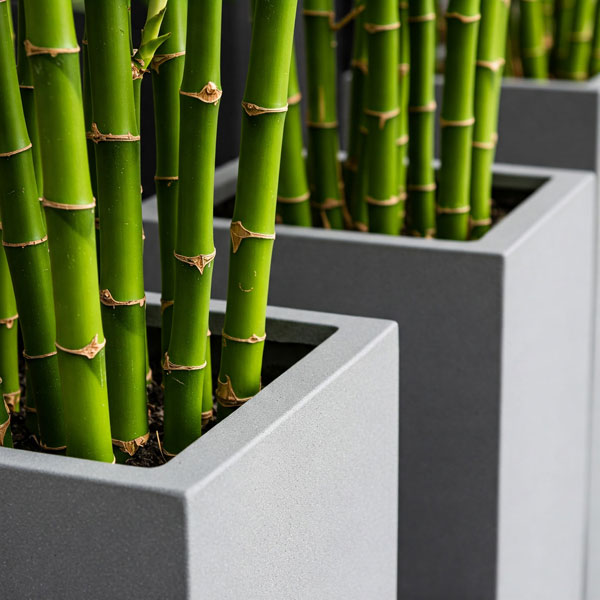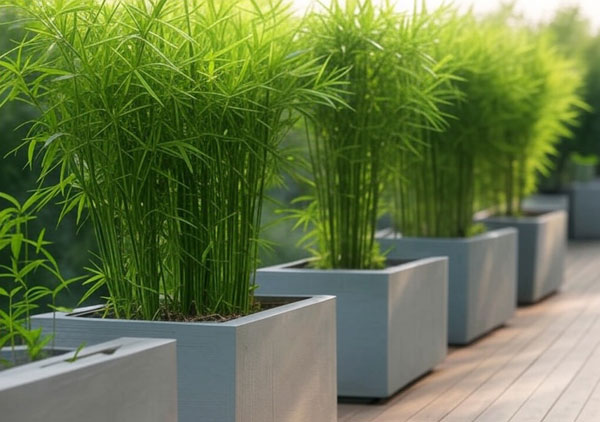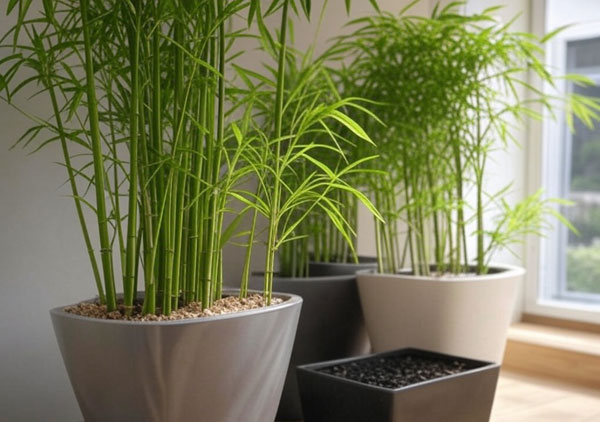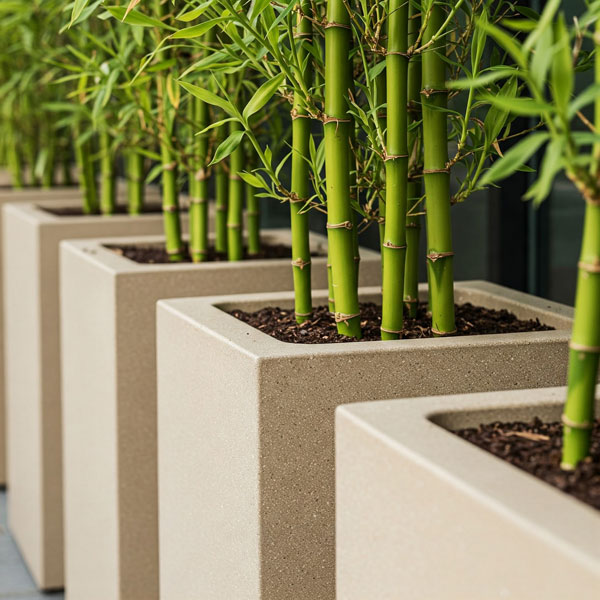Planting bamboo in garden planter boxes has become an increasingly effective and efficient landscape solution, offering benefits ranging from increased privacy to the creation of a tropical oasis. Blending striking visual appeal with practical functionality, bamboo thrives in many diverse climates, from tropical to temperate zones—creates ideal growing conditions for many bamboo species.
Beyond its elegant aesthetic, bamboo serves as a natural solution for privacy screening, wind protection, and adding dynamic texture to patios or urban landscapes. This guide outlines best practices for growing bamboo in containers, with tailored advice on species selection, potting methods, climate-specific care, and sustainable maintenance strategies suited to Australian and other temperate environments.

Planting bamboo in containers offers numerous advantages, making it an appealing choice for gardeners and landscape designers alike.
Benefits of Growing Bamboo in Pots
Space Efficiency
Bamboo is a versatile plant that can thrive in limited spaces, making it ideal for urban gardens, balconies, and patios. By planting bamboo in trough garden pots, you can maximise your use of vertical space, allowing for lush greenery without taking up extensive ground area. This is particularly beneficial in densely populated areas where garden space is at a premium.
Controlled Growth
Container gardening allows for better control over bamboo’s growth habits. While running bamboo species can spread aggressively if planted directly in the ground, growing them in pots helps contain their root systems. This prevents them from overtaking your garden or neighbouring properties, making it easier to manage their size and spread.
Aesthetic Appeal
Bamboo adds a unique aesthetic to any garden or outdoor space. Its tall, slender canes and lush foliage create a striking visual impact. Planters can be strategically placed to enhance privacy or create natural screens around patios or balconies. Additionally, bamboo can be used as decorative elements in various garden designs, adding elegance and tranquillity.
Natural Elegance
Bamboo brings a unique, organic aesthetic to gardens. Its tall, slender culms and lush foliage create a serene and tranquil atmosphere, making it an excellent choice for creating peaceful retreats. The natural tones of bamboo complement various landscape styles, from contemporary to traditional, adding warmth and texture.
Creating Atmosphere
The sound of bamboo rustling in the wind adds an auditory element to garden spaces, contributing to a calming environment. This sensory experience can transform an ordinary garden into a peaceful sanctuary, ideal for relaxation or meditation.

Dynamic Visual Interest
Bamboo’s unique growth patterns and heights create dynamic visual interest in gardens. Different species can be combined to achieve varying heights and textures, allowing for creative landscaping designs that draw the eye and add depth.
Cultural Significance
Incorporating bamboo can evoke cultural themes, particularly those associated with Asian gardens where bamboo is a traditional element. This cultural connection can enhance the garden’s narrative and create a sense of place.
Environmental Benefits
Bamboo is an eco-friendly plant that contributes positively to the environment. It absorbs significant amounts of carbon dioxide and produces more oxygen than many traditional trees, helping combat climate change. Bamboo’s rapid growth rate also means it can be harvested sustainably without damaging the ecosystem, making it an excellent choice for environmentally conscious gardeners
Versatile Uses
Beyond its ornamental value, bamboo has practical applications as well. The sturdy stalks can be used for various purposes, such as stakes for supporting other plants, trellises, or even as building materials for small structures like fences or garden screens. This versatility makes bamboo a functional addition to any garden setup
Once established, bamboo requires relatively low maintenance compared to many other plants. It is drought-resistant and does not typically need pesticides or herbicides to thrive, making it an easy-care option for busy gardeners. Regular watering and occasional fertilization during the growing season are usually sufficient to keep potted bamboo healthy.
Adaptability to Conditions
Bamboo is adaptable to various environmental conditions, thriving in both sunny and partially shaded areas. This flexibility allows gardeners to place bamboo containers in different locations based on sunlight availability, enhancing the overall design of the outdoor space.
Year-Round Interest
Unlike seasonal plants that may die back or become dormant, many bamboo species maintain their foliage year-round, providing continuous interest in the landscape. This evergreen quality ensures that your garden remains vibrant and lively throughout all seasons

Choosing the Right Bamboo Species
Selecting the appropriate bamboo species is crucial for successful container growth. Bamboo can be classified into two primary categories: clumping and running.
Clumping Bamboo
Clumping bamboos grow in tight clusters and are generally more manageable in planters. They are ideal for smaller spaces and urban environments. Recommended varieties include:
Fargesia ‘Red Panda’: This species thrives in partial shade and is suitable for cooler regions.
Bambusa textilis: Known for its tall, elegant appearance, it prefers warmer climates.
Running Bamboo
Running bamboos can spread aggressively if not contained properly, making them less suitable for smaller planters. However, some smaller running varieties can be managed effectively:
Pseudosasa japonica: A hardy variety that adapts well to various conditions.
Phyllostachys aurea: Known for its dense growth, it can be kept in check with regular maintenance.

Pot Selection
Choosing the right pot is essential for the health of your bamboo:
Size: A larger pot (minimum 60cm x 60cm x 60cm) allows for adequate root growth. Bamboo can reach up to 75% of its maximum height when grown in planters.
Material: Use durable materials like fibreglass or lightweight concrete that provide strength and durability.
Shape: Opt for wide, low-profile pots to prevent tipping.

Potting Soil
Bamboo thrives in well-draining potting mixes. Consider these factors when selecting soil:
Quality Soil: Use a high-quality potting mix that retains moisture while allowing excess water to drain.
Nutrient-Rich: Incorporate organic matter such as compost to improve nutrient availability.
Planting Bamboo
Steps for Planting
- Preparation: Fill the pot with your chosen potting mix, leaving space at the top for watering.
- Placement: Remove the bamboo from its nursery container carefully, ensuring minimal root disturbance.
- Positioning: Place the bamboo in the centre of the planter and backfill with soil, eliminating air pockets.
- Watering: Water thoroughly after planting to help settle the soil around the roots.
Watering Requirements
Bamboo requires consistent moisture but should not be waterlogged. Here are some guidelines:
Frequency: During hot Australian summers, daily watering may be necessary; otherwise, water every 2-3 days.
Mulching: Apply a layer of mulch around the base to retain moisture and regulate temperature.
Fertilisation
Bamboo is a heavy feeder that benefits from regular fertilisation:
Type of Fertiliser: Use a high-nitrogen fertiliser (10% or more) during the growing season.
Application Timing: Fertilise in spring as new growth begins and continue every few months.
Maintenance and Care
Maintaining potted bamboo involves regular monitoring:
Pruning: Remove older stems to encourage new growth. Avoid cutting more than one-third of the culms at once.
Repotting: Clumping varieties may need repotting every six years; running types should be divided every three to five years.

Common Issues and Solutions
Growing bamboo in containers can present challenges:
Overwatering: Yellowing leaves may indicate overwatering; ensure proper drainage.
Under-watering: Curling leaves suggest under-watering; increase watering frequency.
Nutrient Deficiency: If growth slows or leaves discolour, adjust fertiliser type or frequency.
Seasonal Considerations in Australia
Australia’s diverse climate means that seasonal care is essential:
Summer Care: During hot months, ensure consistent watering and consider shade cloth to protect young plants from intense sun.
Winter Protection: For younger plants facing their first winter, apply heavy mulch and position pots in sheltered areas to prevent frost damage.
Common Bamboo Pests
Bamboo can be susceptible to various pests, which can affect its health and appearance. Here’s a comprehensive overview of common bamboo pests and effective treatments:
Mealybugs
-
- Appearance: Small, white, cotton-like masses on stems and leaves.
- Damage: Sapsuckers that weaken plants and leave behind a sticky residue (honeydew), leading to sooty mold.
- Treatment: Use systemic or contact insecticides, ensuring to spray all parts of the plant thoroughly. A mixture of soap and water can also be effective. Repeat applications every 10-14 days to break the life cycle
Spider Mites
-
- Appearance: Tiny, spider-like creatures; look for fine webbing on the undersides of leaves.
- Damage: Causes yellowing and stippling on leaves; more active in hot, dry conditions.
- Treatment: Use natural miticides like neem oil or insecticidal soap. Biological controls such as predatory mites can also help manage populations
Aphids
-
- Appearance: Small, soft-bodied insects that can be green, black, or brown.
- Damage: Feed on sap, causing leaf distortion and weakening plants.
- Treatment: Spray with insecticidal soap or a strong stream of water to dislodge them. Introduce natural predators like ladybugs
Bamboo Mites
-
- Appearance: Similar to spider mites but typically smaller.
- Damage: Sucks sap from leaves, leading to discoloration and leaf drop.
- Treatment: Apply horticultural oils or insecticidal soaps; ensure thorough coverage of both leaf surfaces
Borers
-
- Appearance: Larvae that bore into the stems of bamboo.
- Damage: Can cause significant structural damage by tunneling through culms.
- Treatment: Preventive measures include keeping bamboo healthy through proper care; if infestations occur, remove affected culms and apply appropriate insecticides
Treatment Strategies
Preventive Measures
-
- Regularly inspect new bamboo plants for pests before introducing them to your garden.
- Maintain healthy bamboo through proper watering, fertilization, and pruning to reduce susceptibility to pests.
Natural Treatments
-
- Use homemade sprays made from soap and water or horticultural oils for mild infestations. For example, mix 1 tablespoon of mild dish soap with 1 cup of water for a simple solution
- Introduce beneficial insects like ladybugs and predatory mites to naturally control pest populations
Chemical Treatments
-
- If infestations are severe, consider using systemic insecticides like Abamectin or Dinotefuran. Ensure thorough application to all parts of the plant and follow up every two weeks
Always read labels carefully and follow safety guidelines when using chemical treatments.
Physical Methods
-
- For spider mites and other pests, pressure washing with water can dislodge them effectively without harming the plant
- In extreme cases of infestation, it may be necessary to cut back heavily infested areas to promote new growth.
Managing pests in bamboo requires vigilance and a combination of preventive measures and treatment strategies. By regularly inspecting plants, maintaining their health, and employing both natural and chemical solutions when necessary, gardeners can effectively protect their bamboo from common pests while promoting a thriving garden environment.
Conclusion
Planting bamboo in planters offers an excellent opportunity to enhance outdoor spaces across Australia. By selecting appropriate species, using suitable planters and soils, maintaining proper watering and fertilization schedules, and addressing common issues promptly, gardeners can enjoy vibrant bamboo plants year-round. With these guidelines tailored for Australian conditions, anyone can successfully cultivate bamboo in containers while reaping its many benefits.


0 Comments